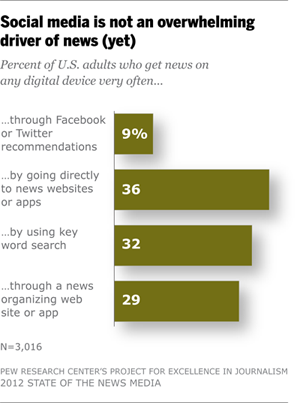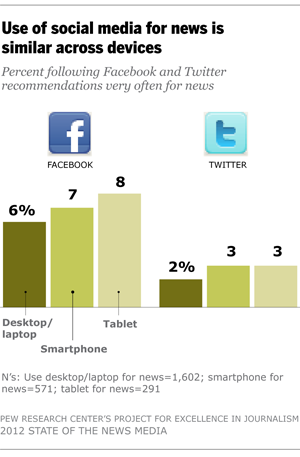Perhaps no topic in technology attracted more attention in 2011 than the rise of social media and its potential impact on news. “If searching for news was the most important development of the last decade, sharing news may be among the most important of the next,” we wrote in a May 2011 report analyzing online news behavior called Navigating News Online.
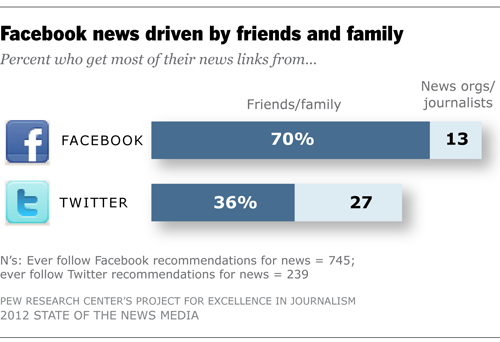
At the moment, Facebook and, to a lesser extent, Twitter, dominate this intersection of social media and news. As written about in detail in the Digital chapter of this report, eMarketer reports that Facebook had 133 million active users in the U.S. at the end of 2011. Facebook defines “active users” as those who interact with Facebook content at least once a month. Despite debates about defining “active users,” there is little question about the site’s popularity or its “stickiness,” the degree to which some users are there a lot: Facebook users spent an average of 423 minutes each on the site in December. By contrast, a PEJ analysis of Nielsen Net View data puts the average time on a top 25 news site at just under 12 minutes per month. Even in 2010, all but one of those top news sites, with the exception being Google News, obtained a portion of their traffic from Facebook. And in 2011, Facebook furthered the news element of its platform with developments like the Social Reader, which allows users to follow, read and share news without ever leaving the network.
How much are consumers relying on Facebook for their daily news information, especially in comparison with using search or going directly to news websites or apps? And when they do get news on these networks, does it come from friends and family or from news organizations they follow? And finally, how is this news viewed?
A new survey released as part of this year’s annual State of the News Media Report probes news consumption and habits on different digital devices, including how news consumers use social media. The broader findings are covered in a companion special report on mobile devices. This report explores in more detail the findings as they relate to social media and news. It explores not only the extent to which social media are used to access news, but also how news behavior on Facebook compares with that on Twitter, and who these social media news consumers are.
Overall, as noted in the companion report, the survey confirms that Facebook and Twitter are now pathways to news, but their role may not be as large as some have suggested. The population that uses these networks for news at all is still relatively small, especially the part that does so very often. Moreover, these social media news consumers have not given up other methods of getting news, such going directly to websites, using apps or through search. In other words, social media are additional paths to news, not replacements for more traditional ones.
The survey also finds that Twitter and Facebook function differently from each other, both in terms of where the news links come from and the degree to which people believe they are encountering different news than they would have encountered elsewhere. Each also draws a different population of users, with Twitter users standing out most. Facebook news users get more news from friends and family and see it as news they might well have gotten someplace else if Facebook did not exist. For Twitter users, though, the news links come from a more even mix of family and friends and news organizations. Most of these users also feel that without Twitter, they would have missed this kind of news.

Facebook and Twitter Are Still Relatively Small Drivers for News
Over all, just 9% of digital news consumers very often follow news recommendations from Facebook or from Twitter on any of the three digital devices (computers, smartphones or tablets). That compares with more than a third, 36%, who very often go directly to news organizations on one of their devices, 32% who get news from search very often, and 29% who turn to some sort of news organizer site or app.
Among just digital news consumers (excluding those who say they do not get news online), the percentage who get at least some news from one of these two leading social networks rises to 52%. But this still trails by a large margin other ways of getting news (92% go directly to news websites and 85% use search).
There are also substantial differences in the data between how people use each of these two forms of social media, what they think about it and who those users are.
Between the Two Social Media Options, Facebook Leads
More than twice as many digital news consumers follow news recommendations from Facebook than follow them from Twitter. And that remains consistent across different digital devices (computers, smartphones or tablets). In all, on any device, 7% get news on Facebook very often, compared with 3% who do so on Twitter. Those populations may grow, or at least involve a broader universe of casual users. Another 19% say they get recommendations via Facebook somewhat often, and 4% via Twitter somewhat often.
The populations do overlap, again with Facebook as the leading platform. Fully 82% of those who ever get some news via Twitter recommendations also get some news via Facebook recommendations, and 40% so do very often or somewhat often. Facebook users, however, are much less likely to be on Twitter than the other way around. Just 27% of Facebook news followers also get news via Twitter, with 11% doing so somewhat or very often. Over all, 13% of digital news consumers follow news recommendations on both Facebook and Twitter – but fewer than 4% do so very or somewhat often.
But There is No Primary Digital Device for Social Media News
The reliance on social recommendations is strikingly similar across desktop/laptops, smartphones and tablet computers. At this early stage in their evolution, in other words, social media users are social media users, and device seems to have little impact on that.
Looking at the heaviest users – the relatively small number of people who rely on social media recommendations for news very often the percentages are similar across devices. Of those who get news on desktop/laptop computers, 6% get news via Facebook recommendations. The same is true for 7% of smartphone news users and 8% of tablet news consumers. For Twitter, the numbers are smaller but follow a similar pattern: 2% of desktop/laptop users follow Twitter recommendations very often on the desktop/laptop, 3% for smartphone news consumers on smartphones and 3% for tablet news consumers on that device.
Social Networks at This Point Are Mostly an Additional Way to Get News, Rather Than a Replacement Source
Another finding is that, contrary to what some observers have argued, the rise of social media recommendations at this point does not appear to be coming at the expense of people going directly to news sites or searching for news topics they are interested in. Instead, social media news consumption is supplemental. This expanded behavior also mirrors what we see in the larger report about news consumptions on different digital devices. Smartphones and tablets do not appear to be replacing computers as much as providing additional ways to get news.
For example, fully 71% of those who ever follow news links on Facebook also get news somewhat or very often by going directly to a news organization’s website or app.1 Among Twitter news followers, 76% also go to home pages or use apps from a news organization very or somewhat often. Similarly 65% of Facebook news users get news via key word search very or somewhat often, as do 69% of Twitter news users.
Twitter and Facebook Function Differently as News Sources
On Facebook, the news comes mostly through family and friends. On Twitter, people tend to get news from a broader mix of recommenders.
When asked who sends you most of the news stories you read or watch via Facebook, 70% said friends and family. Another 13% get most of their recommendations from news organizations or individual journalists. And 10% said most of the news they looked at from social media came from non-news entities that recommend news stories. And 7% said they didn’t know.
Among Twitter news followers, there is much more of a mix: 36% say they get most of their links from friends and family and while 27% do so from news organizations This group was also almost twice as likely (18% on Twitter vs. 10% on Facebook) to look at news recommended to them by non-news organizations. A greater portion on Twitter, were unsure where most of the news recommendations come from or chose not to answer (19%).
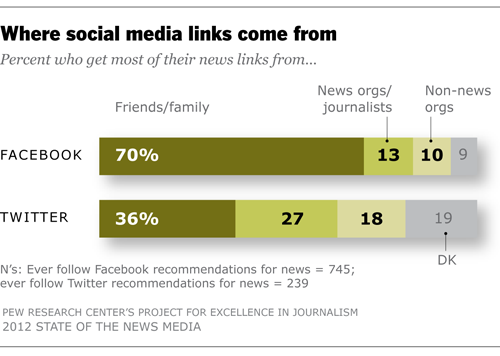
Consumers Are More Likely to See Facebook News as Replaceable
Those who get news via Facebook were more likely to feel the news they received there is news they largely would have gotten elsewhere. A majority, 56%, of those who get news recommendations from Facebook say they think they would have gotten that news from somewhere else. Only a third, 34%, said they would not have seen it otherwise.
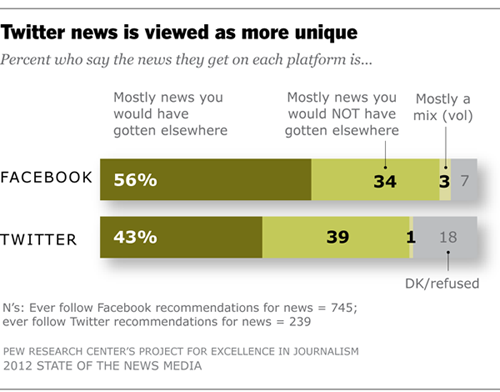
On Twitter, with its somewhat broader mix of sources for news links, there was more sense that the news they encountered this way expanded knowledge or source list. Twitter users were nearly split between the sense that they would get this news elsewhere (43%) and that they would not (39%).
Men and women responded very differently. Women were more likely to see the news as not special to Twitter (53% versus 30% who said they wouldn’t get it elsewhere). Men were more likely to see it as giving them a unique or broader sense of the news (46% versus 35% who said they would get the news elsewhere).
Twitter News Followers Are More Mobile
Twitter news followers tend to be more heavily mobile than the public at large, and they lean toward smartphones in particular.
Fully three-quarters, 76%, of Twitter new followers own a smartphone. That compares with 67% of Facebook news followers and 60% of digital news consumers over all.
Twitter users are also more likely to get news on their smartphone, 64% versus 47% for Facebook users and 30% for all mobile news consumers.
Twitter news followers are more likely than others to own a tablet computer, 42% versus 30% among Facebook news followers and 26% for digital news consumers over all. And they are more likely to get news there, 31%, compared with 20% for both Facebook and for digital news consumers over all.
Who Twitter and Facebook News Users Are
There are some strong demographic differences when you break down those who use Facebook for news and those who use Twitter. Over all, Facebook news followers track with the general population fairly closely, while those who follow Twitter news stand out demographically.
Twitter news followers are more likely to be male, 57% versus 44% of Facebook users and 48% of the population over all. They are also younger; 39% are 18 to 29 years old, which is nearly double the population over all (22%), but about the same as Facebook users (37%).
They are highly educated. More than a third (37%) have a college degree or beyond, higher than the 28% for all adults, and fewer have no more than a high school diploma (34% versus 44% over all). They are less white than the population over all and less white than Facebook news users.
Facebook users mirror in more ways the population over all, but these news consumers are far more likely than the population over all and than their Twitter counterparts to have children in the house (37% versus 29% for Twitter and 31% of all adults).
About the Survey
The analysis in this report, What Facebook and Twitter Mean for News, is based on aggregated data from three telephone surveys conducted in January 2012 (Jan. 12-15, Jan. 19-22 and Jan. 26-29) with national samples of adults 18 years of age or older living in the continental United States. Interviews were conducted with a total of 3,016 adults (1,809 respondents were interviewed on a landline telephone, and 1,207 were interviewed on a cellphone, including 605 who had no landline telephone). The survey was conducted by interviewers at Princeton Data Source under the direction of Princeton Survey Research Associates International. A combination of landline and cellphone random digit dial samples were used; both samples were provided by Survey Sampling International. Interviews were conducted in English. Respondents in the landline sample were selected by randomly asking for the youngest adult person who was then at home. Interviews in the cellphone sample were conducted with the person who answered the phone, if that person was an adult 18 years of age or older.
The combined landline and cellphone sample are weighted using an iterative technique that matches gender, age, education, race, Hispanic origin and region to parameters from the March 2011 Census Bureau’s Current Population Survey and population density to parameters from the Decennial Census. The sample also is weighted to match current patterns of telephone status, based on extrapolations from the 2011 National Health Interview Survey. The weighting procedure also accounts for the fact that respondents with both landline and cellphones have a greater probability of being included in the combined sample and adjusts for household size within the landline sample. Sampling errors and statistical tests of significance take into account the effect of weighting. The following table shows the sample sizes and the error attributable to sampling that would be expected at the 95% level of confidence for different groups in the survey:
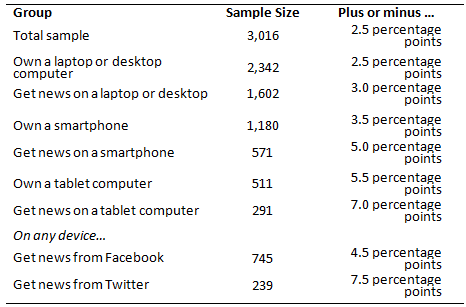
Sample sizes and sampling errors for other subgroups are available upon request.
In addition to sampling error, one should bear in mind that question wording and practical difficulties in conducting surveys can introduce error or bias into the findings of opinion polls.
